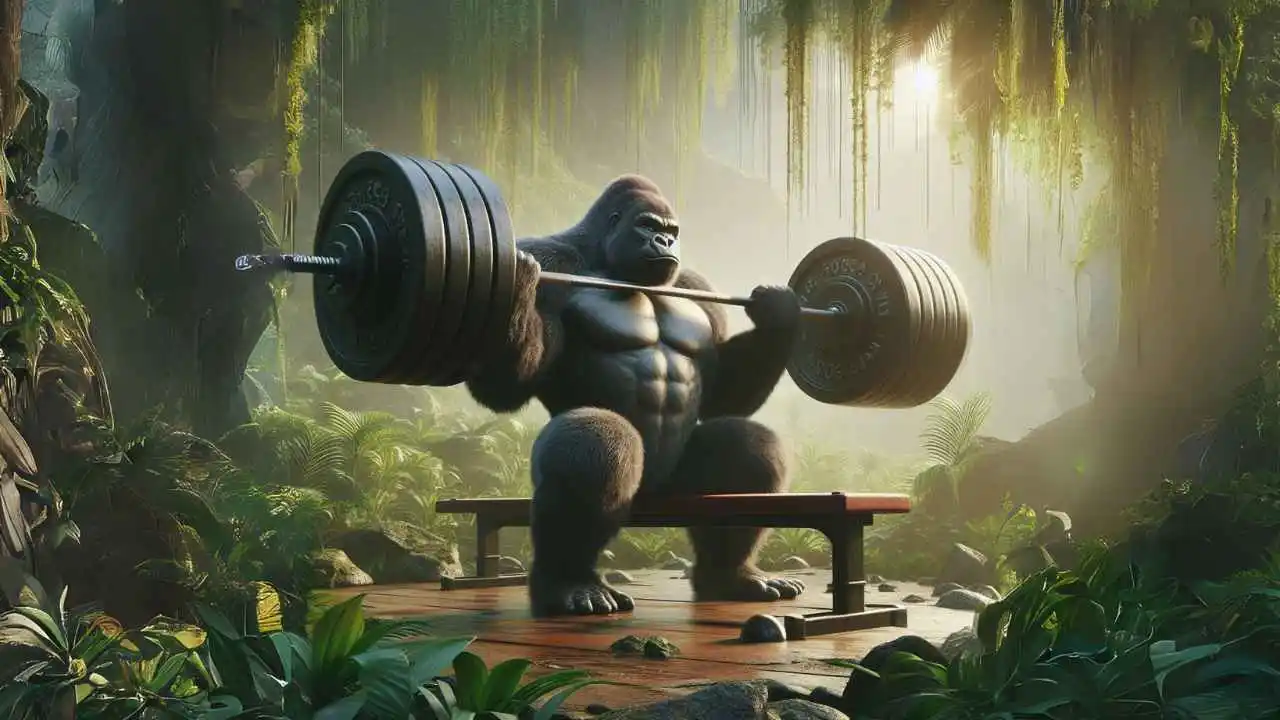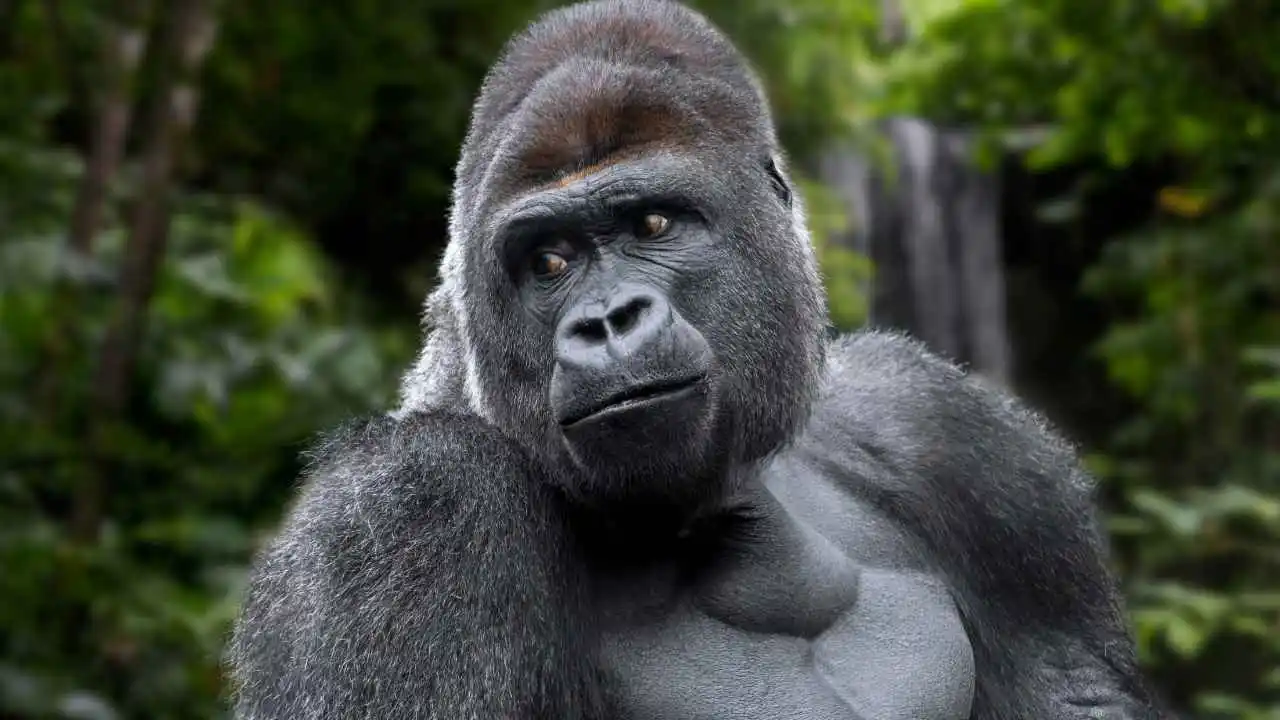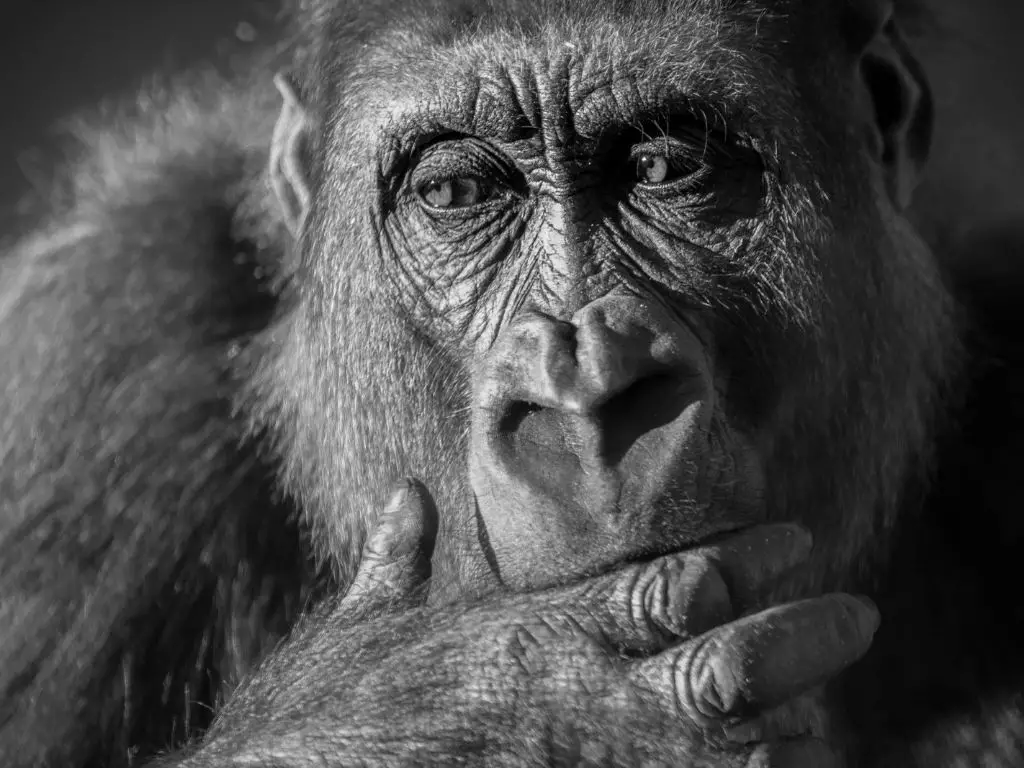When we talk about strength in the animal kingdom, gorillas are one of the first creatures that come to mind. These magnificent primates, known for their imposing presence and gentle nature, are a marvel of natural strength and power.
In terms of sheer muscle power, gorillas are leagues ahead of the average human. An adult male gorilla, or silverback, can weigh up to 400 to 500 pounds, most of which is pure muscle. Compared to humans, gorillas have a more significant amount of muscle mass, which contributes to their incredible strength.
But how does this translate in terms we can understand? Well, while it’s challenging to make a direct comparison, estimates suggest that a gorilla could be around four to nine times stronger than the average human. This means that feats of strength that are impressive for humans, like lifting heavy weights, would be relatively easy for a gorilla.
However, it’s not just about the raw power. Gorillas have a strength that is functional and essential for their survival. They use their formidable strength for various activities in their natural habitat, such as climbing trees, foraging for food, and, of course, in social dominance displays.
In the following sections, we’ll dive deeper into the fascinating world of gorilla strength, exploring how they might fare in a human-like test of strength, such as the bench press, and understanding the role of this incredible power in their daily lives and social structures. Join us as we uncover the might of these gentle giants of the forest.
How Much Can a Gorilla Bench
Understanding Gorilla Anatomy and Muscle Structure

To truly appreciate the strength of gorillas, we need to take a closer look at their anatomy and muscle structure. These aspects of their physical build are not just impressive but are perfectly adapted to their lifestyle in the wild.
Firstly, let’s talk about muscle mass. Gorillas have an extraordinary amount of it. Their bodies are dominated by muscles, especially in the upper body. The arms of a gorilla are particularly muscular and much larger in proportion compared to humans. This muscle distribution is crucial for their day-to-day activities, like climbing and foraging.
The type of muscle fibers in gorillas also plays a significant role in their strength. While humans have a mix of slow-twitch and fast-twitch muscle fibers, gorillas are believed to have a higher proportion of fast-twitch fibers. These fibers are designed for strength and power, allowing gorillas to perform incredible feats of strength, like uprooting trees or breaking bamboo.
Another key aspect is their limb structure. Gorillas have long arms and relatively short legs. This arm-to-leg length ratio is quite different from humans and gives them a significant mechanical advantage. Their long arms allow them to practice ‘knuckle-walking’ – walking on their knuckles with their arms supporting most of their body weight. This mode of movement requires immense upper body strength, something that gorillas have adapted to perfectly.
In the wild, these anatomical features are essential for survival. The dense forests of central Africa, where gorillas live, demand a lot of climbing, reaching for food, and moving through thick vegetation. Their strength allows them to break through this dense foliage, climb to find food, and defend themselves or their group if needed.
Moreover, the social structure of gorillas necessitates this strength. The dominant silverback, for instance, uses his strength to protect his group, assert dominance, and maintain order. It’s not just about being strong; it’s about using that strength to fulfill various roles within the group.
Estimating Gorilla Strength: Bench Press Comparison

When we try to measure the strength of a gorilla, especially in terms we’re familiar with like the bench press, we run into a fascinating mix of challenges and estimations. It’s like trying to compare apples to oranges, but let’s delve into this intriguing topic.
First off, it’s important to understand that gorillas don’t bench press, and getting them to perform a human-style bench press to measure their strength is, of course, not feasible. So, scientists and experts have to rely on observations and indirect comparisons to estimate their strength.
One of the biggest challenges in comparing gorilla strength to human benchmarks is the difference in anatomy and muscle usage. Gorillas are quadrupeds, meaning they walk on all fours (using knuckle-walking), and their muscle structure is optimized for this kind of movement and other activities like climbing and lifting heavy objects. Humans, on the other hand, are bipeds and our muscles are adapted to our upright walking and different range of motions.
Despite these differences, there have been some attempts to quantify gorilla strength in human terms. For instance, it’s often said that a gorilla could be as much as four to nine times stronger than a human. This estimate comes from comparing the muscle structure and fiber composition of gorillas to humans, as well as observing their day-to-day activities that demonstrate their strength, like lifting or breaking heavy objects.
There’s a famous anecdote about a zoo gorilla named Jambo, who reportedly bent an iron bar of his enclosure, something that would require immense strength if compared to human standards. While these stories aren’t scientific measurements, they do give us a glimpse into the extraordinary strength these animals possess.
Another way to look at it is through the lens of their natural behavior. Gorillas have been observed to uproot heavy trees or break thick bamboo canes with ease, tasks that would require significant strength if a human were to attempt them.
Gorilla Lifting Techniques vs. Human Techniques
When we think about lifting weights, images of gym-goers and athletes bench pressing and deadlifting might come to mind. But how does this compare to how a gorilla, one of nature’s strongest creatures, lifts and pulls?
Gorillas, in their natural habitat, demonstrate incredible strength, but their methods are quite different from human weightlifting techniques. For starters, gorillas don’t lift weights for exercise or competition; their lifting is purely functional, a part of their daily survival.
Gorilla Lifting Techniques
- Natural Movements: Gorillas use their strength in more practical ways, like pulling down branches to eat leaves, moving heavy objects in their path, or even breaking bamboo. Their lifting is more about brute force and less about technique.
- Whole Body Use: Unlike humans who often isolate muscle groups when lifting, gorillas use their entire body. When they uproot a tree, for instance, they engage muscles from their hands to their shoulders, back, and even legs.
- Knuckle-Walking: This unique form of movement involves supporting their body weight on their knuckles. It requires immense upper body strength, something they use in other aspects of their life, like lifting or fighting.
Human Weightlifting Techniques
- Structured and Specific: Human lifting techniques, especially in sports and fitness, are highly structured. Athletes train specific muscles for specific movements, like a bench press or a bicep curl.
- Use of Equipment: Humans use external weights and equipment to build strength. This includes barbells, dumbbells, and machines designed to target specific muscle groups.
- Form and Technique: In human weightlifting, form and technique are crucial. Proper form ensures maximum efficiency and reduces the risk of injury.
Why Direct Comparisons Are Complex
Comparing gorilla strength to human strength, especially in terms of specific exercises like bench pressing, is complex and speculative for several reasons:
- Different Anatomies: Gorillas and humans have different body structures. Gorillas have longer arms relative to their bodies, and their muscle distribution is different, making direct comparisons tricky.
- Different Objectives: Humans lift weights for strength, fitness, or competition. Gorillas use their strength for survival, which involves different movements and objectives.
- Measurement Challenges: There’s no practical way to measure how much a gorilla can lift in a controlled environment like a human weightlifting competition.
Behavioral Aspects of Gorilla Strength

Gorillas, with their impressive strength, are the powerhouses of their natural habitats. This strength isn’t just for show; it plays a crucial role in their daily activities and social interactions.
In the wild, gorillas use their strength primarily for foraging and climbing. They can effortlessly break apart tough vegetation like bamboo, which makes up a significant part of their diet. Imagine trying to snap a thick, hard bamboo stick with your bare hands – it’s a task that would be nearly impossible for a human, but it’s a breeze for a gorilla. This ability to break and bend tough plant material allows them access to food sources that would otherwise be unreachable.
Climbing is another area where their strength is on full display. Despite their size, gorillas are surprisingly agile climbers, especially the younger and lighter ones. They use their muscular arms to pull themselves up and navigate through the trees with ease, a feat that requires significant power and endurance.
In terms of social interactions, gorillas use their strength in more subtle ways. For instance, silverback gorillas, the dominant males of the groups, often showcase their strength in displays that involve thumping their chests, standing upright, and even tearing up vegetation. These displays are not just about showing off; they’re a way of maintaining order and asserting dominance without resorting to actual violence.
The Role of Strength in Gorilla Social Structure
In gorilla society, physical strength is a key factor in determining hierarchy, particularly among silverback males. The strongest male typically becomes the leader of the group, responsible for the safety and well-being of the members. This leadership role involves protecting the group from threats, mediating conflicts, and leading the group to different feeding sites.
Strength also plays a significant role in mating. Female gorillas are often attracted to the strongest males, as their strength is a sign of good genetics and the ability to provide protection. The silverback’s strength ensures that he can maintain his status as the dominant male, which includes mating rights with the females in the group.
In group dynamics, the silverback’s strength is a stabilizing force. His ability to assert dominance peacefully, mainly through displays of strength, helps prevent conflicts within the group and keeps potential rivals in check. It’s a delicate balance of power, where strength is used more as a deterrent than a tool for aggression.
Conclusion: The Fascination with Gorilla Strength
The strength of gorillas is a subject that has long captivated both scientists and the general public. These magnificent creatures, with their incredible physical power and gentle nature, offer a fascinating glimpse into the wonders of the animal kingdom.
Gorillas are among the strongest animals on the planet, with a muscular build and physical capabilities far surpassing those of humans. Their strength is evident in their daily activities – from breaking tough bamboo and foraging to climbing trees and social displays of power. This strength isn’t just about brute force; it’s an essential part of their survival, enabling them to navigate their environment, access food, and protect themselves and their group.
In the social structure of gorilla groups, strength plays a pivotal role. The dominant silverback uses his strength to maintain order, protect his group, and assert his position. This use of strength in a social context is a testament to the complex social dynamics of gorilla groups and their intelligence.
Our fascination with gorilla strength reflects a broader human interest in the natural world and its many wonders. It speaks to our curiosity about other species, their behaviors, and how they compare to us. This interest is not just about marveling at their physical abilities; it’s also about understanding our place in the natural world and the importance of preserving these remarkable creatures.
Gorillas, with their close genetic ties to humans, remind us of our connection to the natural world. They are a symbol of the wild’s raw beauty and power, and learning about them can inspire a deeper respect and a sense of responsibility for the natural world.
References and Further Reading
For those interested in exploring more about gorilla biology and conservation, here are some credible sources:
- “Gorillas in the Mist” by Dian Fossey: This classic book provides an intimate look at the lives of mountain gorillas and the groundbreaking work of Dian Fossey.
- The Dian Fossey Gorilla Fund International: Their website offers a wealth of information on gorilla behavior, conservation efforts, and how you can help.
- National Geographic: Known for its wildlife documentaries and articles, National Geographic provides in-depth coverage of gorillas and other wildlife.
- World Wildlife Fund (WWF): The WWF website has extensive information on various species, including gorillas, and their conservation status.
- “The Behavior Guide to African Mammals” by Richard Estes: This book includes detailed information on the behavior of gorillas and other African mammals.




Leave a Reply